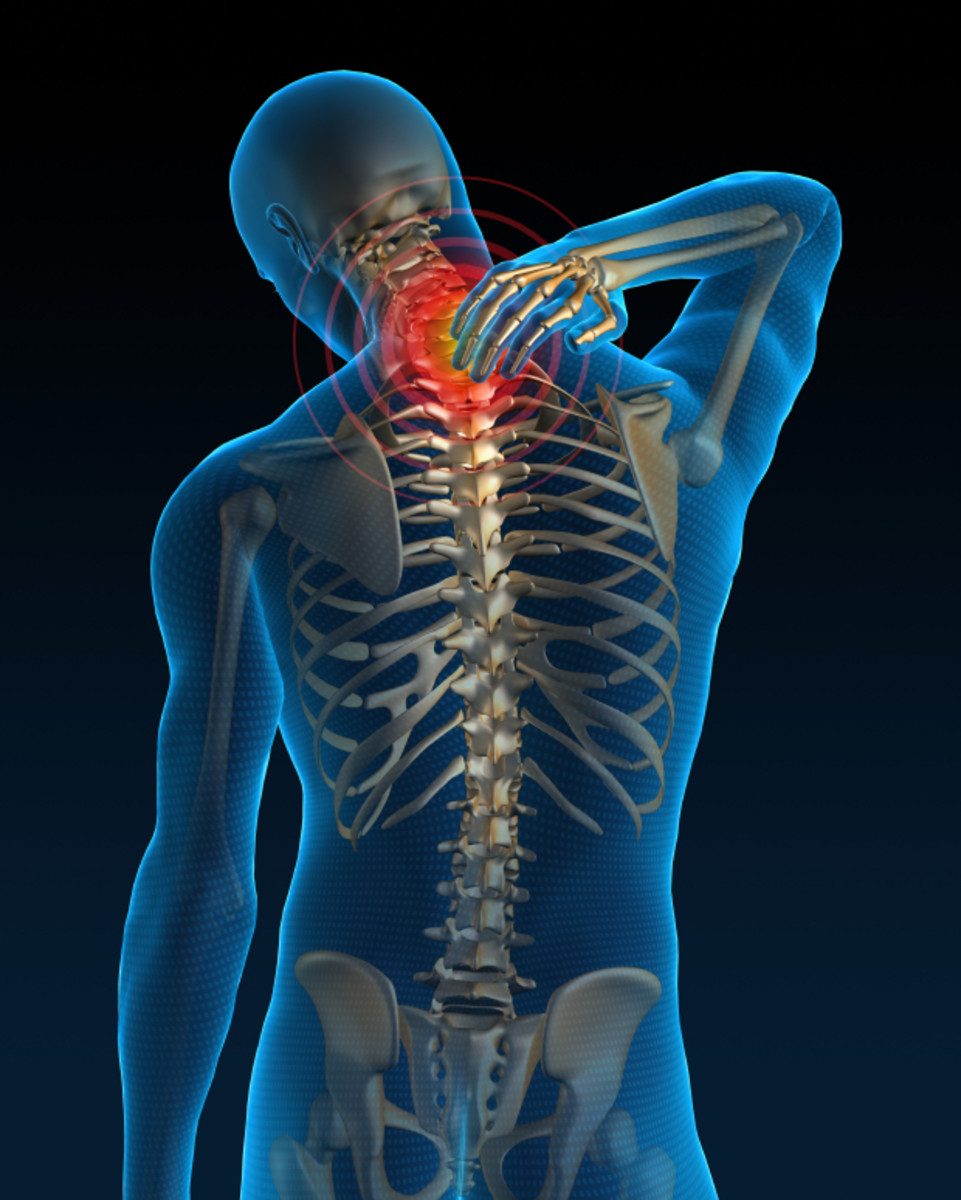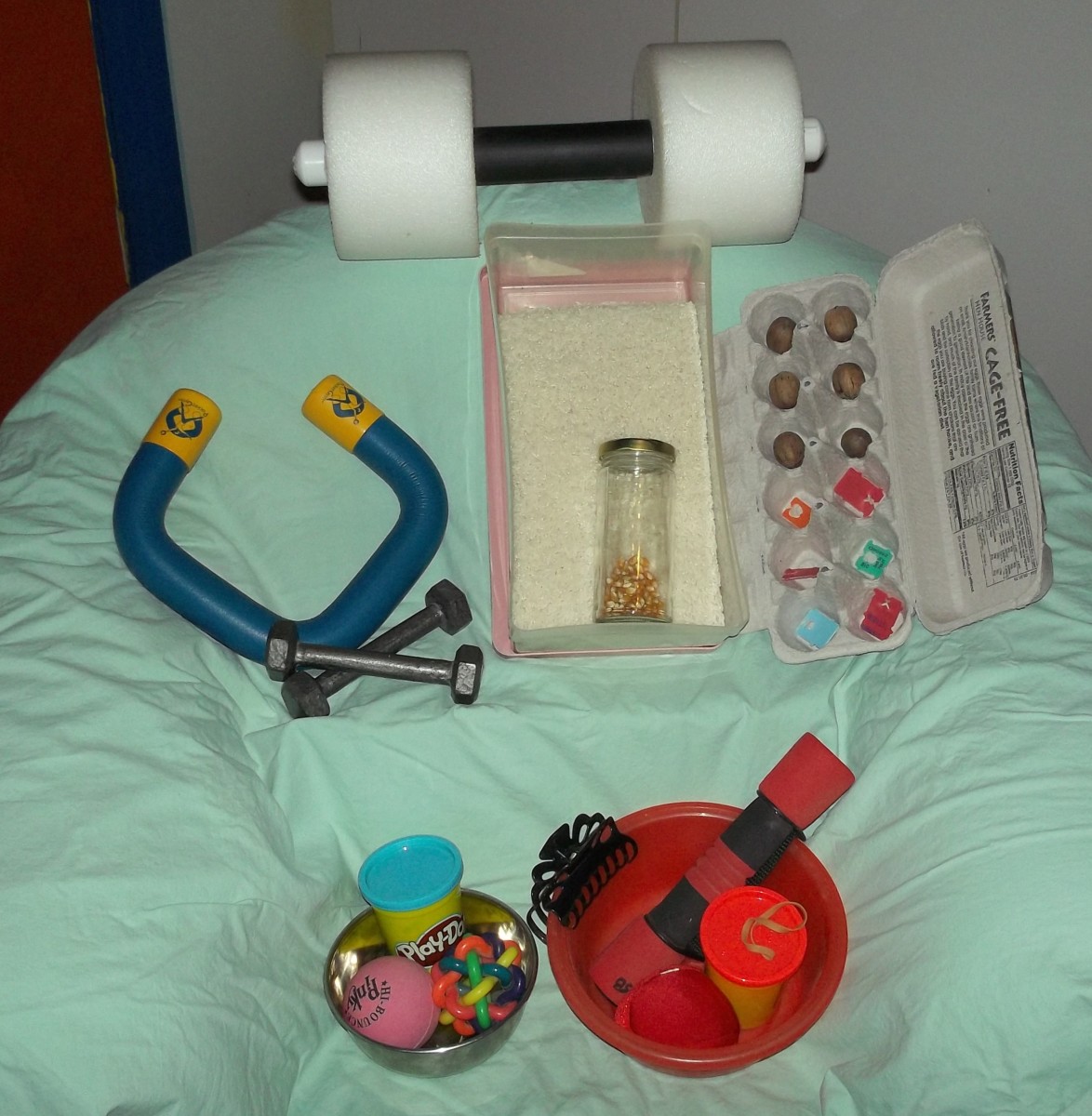Carpal Tunnel Syndrome - Home Management Part 3 - Exercises
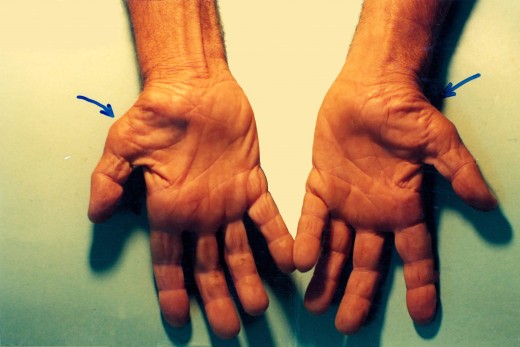
Introduction
It is very essential that any activity that may cause or enhance the symptoms of Carpal Tunnel Syndrome must be stopped forthwith. Once the acute stage has subsided, exercise programs are indicated. To start with pain free, active and carefully guided passive range of motion exercises may be selected. The exercises may be slowly progressed to stretching and strengthening exercises. But care must be taken that these exercises must not, in anyway, cause or enhance the symptoms. These exercises must be done within the limits of pain and discomfort. If painful exercises are attempted they may exert additional stress and strain to the already compressed or irritated Median Nerve. Exercises are essential as they maintain the range of motion of the joints as they stretch the muscles, the ligaments, the tendons, the fascia and the joint capsules around the joints. These exercises also maintain the tone of the muscles and the strength of the muscles. They also help to maintain the blood circulation to the soft tissues around the joints. In this article I would like to discuss certain exercises that may help to relieve the pressure or irritation on the Median Nerve and thus to relieve the symptoms of Carpal Tunnel Syndrome.
Anyway before resorting to the exercise program, it is advisable to seek the advice of a qualified physiotherapist.
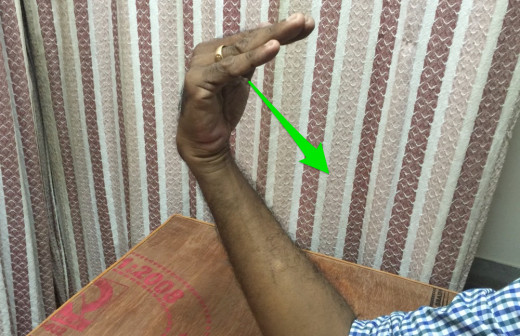
1. Active Exercise 1
Let the patient has right Carpal Tunnel Syndrome.
Starting Position- The patient sits on a chair in front of a table facing it. He keeps his bend right elbow on the table in such a way that the elbow is flexed approximately to 45 degrees with the forearm and the palmar aspect of the right hand facing upwards with the wrist in the neutral position and the fingers held extended. Now the right wrist is extended (bring downwards) approximately to 90 degrees with the fingers still held in extension.
Exercise- Slowly and gently lift up the right hand (flex the wrist) with the fingers still held in extension till the maximum flexion is reached. Hold in that maximum attained flexed position for 3 seconds. Slowly and gently return back to the starting position. Repeat the exercise 5 times, thrice a day. Care should be taken that the exercise, in anyway, should not precipitate or enhance the symptoms. The exercise may also be done with the fingers flexed (made into a fist).
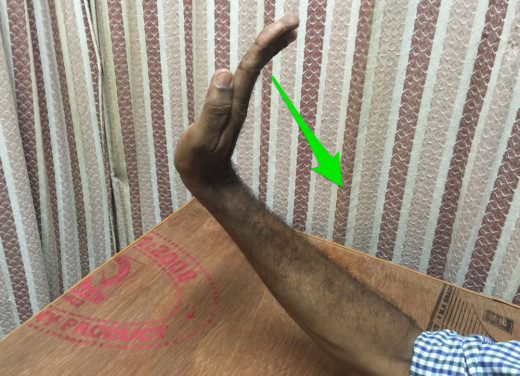
2. Active Exercise 2
Let the patient has right Carpal Tunnel Syndrome.
Starting Position- The patient sits on a chair near a table facing it. He keeps his bend right elbow on the table in such a way that the elbow is flexed approximately to 45 degrees with the forearm and the palmar aspect of the right hand facing downwards with the wrist in the neutral position and the fingers held extended. Now the right wrist is flexed (bring downwards) approximately to 90 degrees with the fingers still held in extension.
Exercise- Slowly and gently lift up the right hand (extend the wrist) with the fingers still held in extension till the maximum extension is reached. Hold in that maximum attained extended position for 3 seconds. Slowly and gently return back to the starting position. Repeat the exercise 5 times, thrice a day. Care should be taken that the exercise, in anyway, should not precipitate or enhance the symptoms. The exercise may also be done with the fingers flexed (made into a fist).
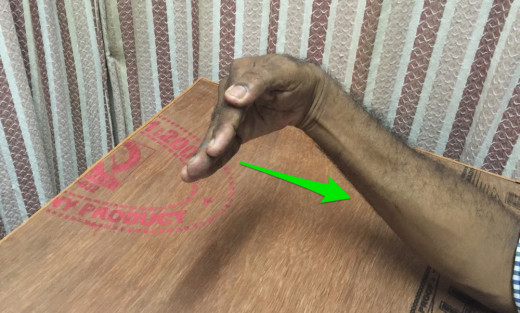
3. Active Exercise 3
Let the patient has right Carpal Tunnel Syndrome.
Starting Position- The patient sits on a chair near a table in front of it. He keeps his bend right elbow on the table in such a way that the right elbow is flexed approximately to 45 degree with the ulnar border (inner side) of the right forearm and the right hand facing downwards with the wrist in the neutral position and the fingers held extended.
Exercise- Slowly and gently flex the right wrist (bend the wrist inwards) with the fingers still held extended so that a stretch is felt along the extensor aspect (back side) of the right forearm. Hold in the maximum stretched position for 3 seconds. Now relax. Bring back the wrist and fingers to the neutral position. Now slowly and gently extend the right wrist (bend the wrist outwards) with the fingers still held extended so that a stretch is felt along the flexor aspect (front side) of the right forearm. Hold in the maximum stretched position for 3 seconds. Now relax. Bring back the wrist and fingers to the neutral position. The whole exercise is repeated 5 times, thrice a day. Care should be taken that the exercise, in anyway, should not precipitate or enhance the symptoms. The exercise may also be done with the fingers flexed (made into a fist).
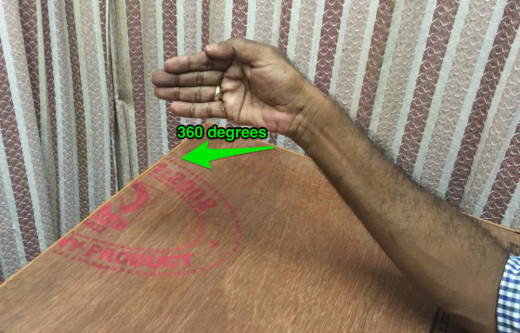
4. Active Exercise 4
Let the patient has right Carpal Tunnel Syndrome.
Starting Position- The patient sits on a chair near a table in front of it. He keeps his bend right elbow on the table in such a way that the right elbow is flexed approximately to 45 degrees with the forearm and the palmar aspect of the right hand facing downwards with the wrist in the neutral position and the fingers held extended.
Exercise- Slowly and gently rotate the right wrist in the clockwise direction with the fingers still held extended, 5 times. Now relax. Now slowly and gently rotate the right wrist in the anti clockwise direction with the fingers still held extended, 5 times. This exercise is done thrice a day. Care should be taken that the exercise, in anyway, should not precipitate or enhance the symptoms. The exercise may also be done with the fingers flexed (made into a fist).
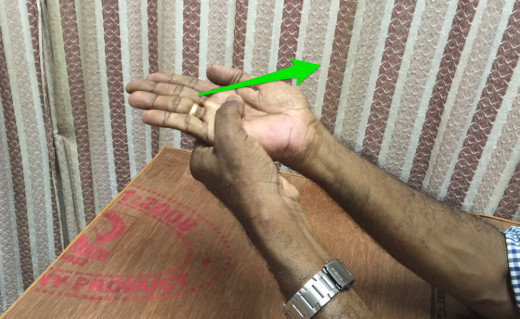
5. Strengthening Exercise 1
Let the patient has right Carpal Tunnel Syndrome.
Starting Position- The patient sits on a chair in front of a table facing it. He keeps his bend right elbow on the table in such a way that the elbow is flexed approximately to 45 degrees with the forearm and the palmar aspect of the right hand facing upwards with the wrist in the neutral position and the fingers held extended. Now the right wrist is extended (bring downwards) approximately to 90 degrees with the fingers still held in extension.
Exercise- The patient holds his right hand with his left hand in such a way that the fingers of the left hand lie on the dorsal aspect ( back side) of the palm of the right hand and the left thumb lies on the palmar aspect (front side) of the palm of the right hand. The patient lifts up (flexes) the right wrist with the fingers still held in extension to which a minimal resistance is offered by the left hand. The resistance offered by the left hand must be gradual, slow and gentle so that it does not cause any discomfort to the right wrist. The degree of resistance offered by the left hand must be such that the right wrist must be able to attain the maximum flexion irrespective of the resistance offered by the left hand. Hold on to the maximum attained flexed position for 2 seconds. Now the hold by the left hand is released. Relax and return back to the starting position. Repeat the exercise 5 times, thrice a day.
Care should be taken that the exercise, in anyway, should not precipitate or enhance the symptoms.
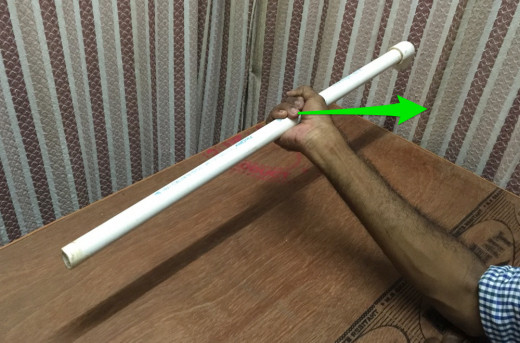
6. Strengthening Exercise 2
Exercise No.5.can also be done with certain variation.
Instead of the resistance offered by the left hand by holding the right hand, the resistance can be offered by holding a stick at its middle and parallel to the table.
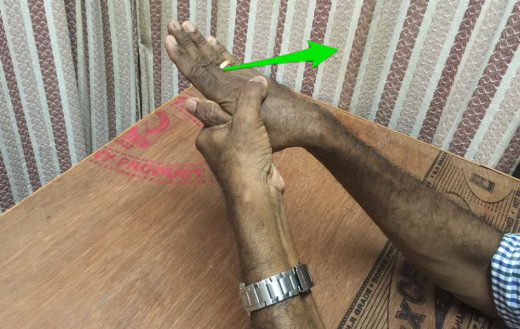
7. Strengthening Exercise 3
Let the patient has right Carpal Tunnel Syndrome.
Starting Position- The patient sits on a chair in front of a table facing it. He keeps his bend right elbow on the table in such a way that the elbow is flexed approximately to 45 degrees with the forearm and the palmar aspect of the right hand facing downwards with the wrist in the neutral position and the fingers held extended. Now the right wrist is flexed (bring downwards) approximately to 90 degrees with the fingers still held in extension.
Exercise- The patient holds his right hand with his left hand in such a way that the fingers of his left hand lie on the palmar aspect (front side) of the palm of the right hand and the left thumb lies on the dorsal aspect (back side) of the palm of the right hand. The patient lifts up (extends) the right wrist with the fingers still held in extension to which a minimal resistance is offered by the left hand. The resistance offered by the left hand must be slow, gradual and gentle so that it does not cause any discomfort to the wrist. The degree of resistance offered by the left hand must be such that the right wrist must be able to attain the maximum extension irrespective of the resistance offered by the left hand. Hold on to the maximum attained extended position for 2 seconds. Now the hold by the left hand is released. Relax and return back to the starting position. Repeat the exercise 5 times, thrice a day. Care should be taken that the exercise, in anyway, should not precipitate or enhance the symptoms.
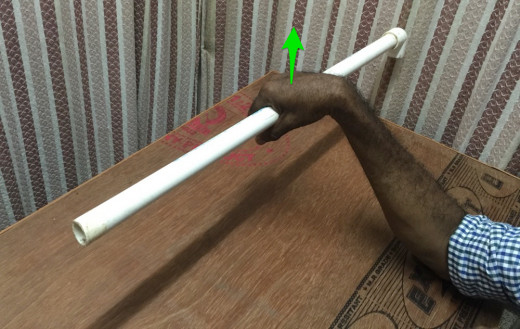
8. Strengthening Exercise 4
Exercise. No.7. can also be done with certain variation.
Instead of the resistance offered by the left hand by holding the right hand, the resistance may be offered by holding a stick at its middle and parallel to the table.
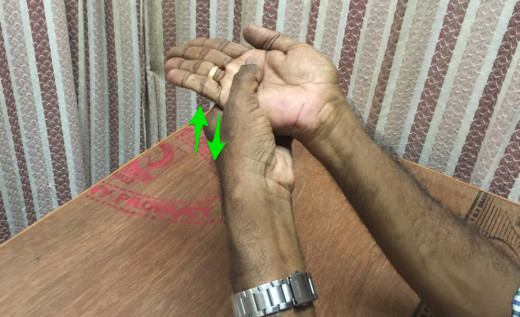
9. Strengthening Exercise 5 - (Isometric Exercise.1)
Let the patient has right Carpal Tunnel Syndrome.
Starting Position- The patient sits on a chair near a table facing it. He keeps his bend right elbow on the table in such a way that the elbow is flexed approximately to 45 degrees with the anterior aspect (front side) of the right forearm and the palmar aspect of the right hand facing upwards with the wrist in the neutral position and the fingers held extended.
Exercise- The patient holds his right hand with his left hand in such a way that the fingers of his left hand lie on the dorsal aspect (back side) of the palm of the right hand and the left thumb lies on the palmar aspect (front side) of the palm of the right hand. Now the patient lifts up (flexes) right wrist with the fingers still in extension to which a resistance is offered by the left hand. The effort of the patient to lift up (flex) the right wrist is opposed by an equal and opposite force (resistance) offered by the left hand which is holding it. Hence no movement occurs at the right wrist joint. But the flexor group of muscles (the muscles on the front side) of the right forearm contract isometrically. Such an isometric contraction of the flexor group of muscles of the right forearm strengthens them. Hold in the maximum contracted position for 2 seconds. Now the ‘hold’ by the left hand is released. Relax. Repeat the exercise 5 times, thrice a day. Care should be taken that the exercise, in anyway, should not precipitate or enhance the symptoms. The same exercise may be done by holding the right wrist at varying degrees of flexion.
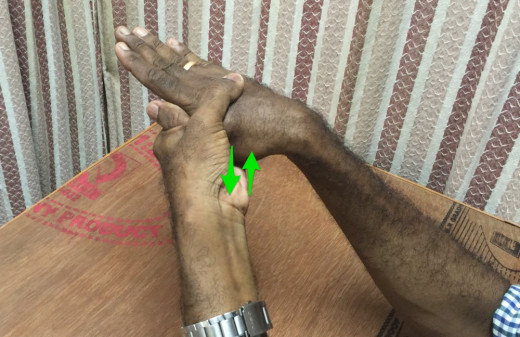
10. Strengthening Exercise. 6 - (Isometric Exercise. 2)
Let the patient has right Carpal Tunnel Syndrome.
Starting Position- The patient sits on a chair near a table facing it. He keeps his bend right elbow on the table in such a way that the elbow is flexed approximately to 45 degrees with the anterior aspect (front side) the right forearm and the palmar aspect of the right hand facing downwards with the wrist in the neutral position and the fingers held extended.
Exercise- The patient holds his right hand with his left hand in such a way that the fingers of his left hand lies on the palmar aspect (front side) of the palm of the right hand and the left thumb lies on the dorsal aspect (back side) of the palm of the right hand. Now the patient lifts up (extends) right wrist with the fingers still in extension to which a resistance is offered by the left hand. The effort of the patient to lift up (extend) the right wrist is opposed by an equal and opposite force (resistance) offered by the left hand which is holding. Hence no movement occurs at the right wrist joint. But the extensor group of muscles (muscles on the back side) of the right forearm contract isometrically. Such an isometric contraction of the extensor group of muscles of the right forearm strengthens them. Hold in the maximum contracted position for 2 seconds. Now the ‘hold’ by the left hand is released. Relax. Repeat the exercise 5 times, thrice a day. Care should be taken that the exercise, in anyway, should not precipitate or enhance the symptoms.
The same exercise may be done by holding the right wrist at varying degrees of extension.
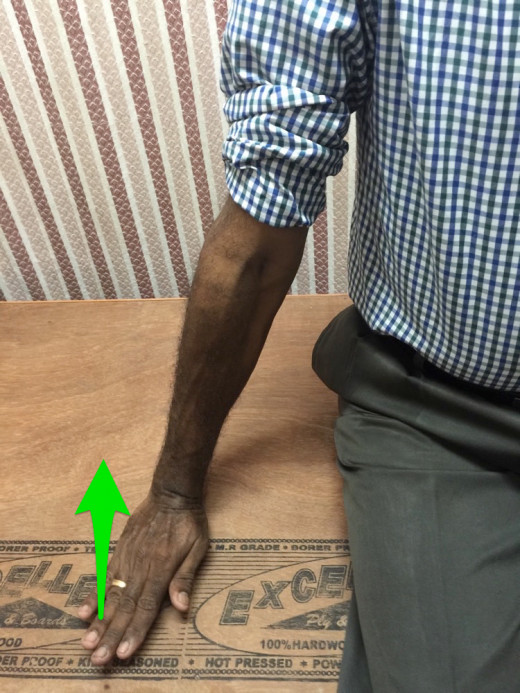
11. Stretching Exercise 1
Let the patient has right Carpal Tunnel Syndrome.
Starting Position- The patient sits at the edge of a table or a bed with the legs hanging down. Exercise- The patient extends his right wrist and keeps the palmar aspect of the right hand on the bed with the fingers held extended (straightened). Now extend (straighten) the right elbow with the palmar aspect of the right hand still on the bed with the fingers still held extended (straightened). Now a stretch is felt along the flexor aspect (front side) of the right forearm. Now extend the right wrist further so that the palmar aspect of the right hand and the fingers is off the bed with the fingers still held in extension so that a maximum stretch is felt along the flexor aspect (front side) of the right forearm. Hold in the maximum stretched position for 2 seconds. Now slowly and gently return back to the starting position. Repeat the exercise 5 times, thrice a day- may be progressed to 10 times, thrice a day. Avoid severe strain to the right wrist. Care should be taken that the exercise, in anyway, should not precipitate or enhance the symptoms. If so, discontinue the exercise forthwith.
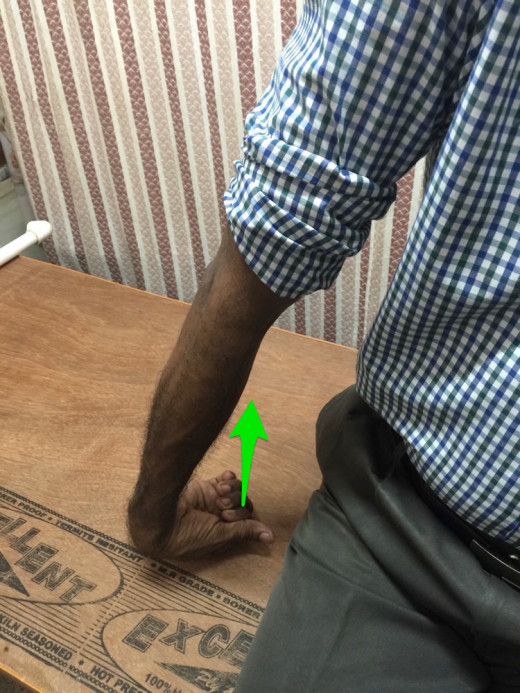
12. Stretching Exercise 2
Let the patient has right Carpal Tunnel Syndrome.
Starting Position- The patient sits at the edge of a table with the legs hanging. Exercise- The patient flexes (bends) his right wrist and keeps the dorsal aspect of the right hand on the bed with the fingers held extended (straightened). In this position, the right elbow may be in a flexed (bend) position. Now extend (straighten) the elbow with the dorsal aspect of the right hand still on the bed with the fingers still held extended (straightened). Now a stretch is felt along the extensor aspect (back side) of the right forearm. Now flex the right wrist and the fingers further and try to touch the palmar aspect of the right hand with the finger tips so that a maximum stretch is felt along the extensor aspect (back side) of the right forearm. Hold in the maximum stretched position for 2 seconds. Now slowly and gently return back to the starting position. Repeat the exercise 5 times, thrice a day- may be progressed to 10 times, thrice a day. Avoid severe strain to the right wrist. Care should be taken that the exercise, in anyway, should not precipitate or enhance the symptoms. If so, discontinue the exercise forthwith.
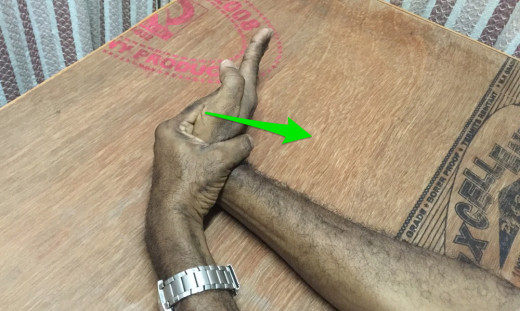
13. Stretching Exercise 3
Let the patient has right Carpal Tunnel Syndrome.
Starting Position- The patient sits on a chair near a table facing it. He keeps his right forearm and right hand on the table in such a way that the ulnar border (inner side) of the right forearm and right hand rest on the table with the right wrist in the neutral position and the fingers held extended. Exercise- Now extend (taking the right hand outward) the right wrist actively so that a stretch is felt along the flexor aspect (front side) of the right forearm. Now hold the right wrist and the right hand by the left hand in such a way that the left thumb wraps round the right wrist and the left fingers lie across the palm of the right hand parallel to the right hand and right fingers (as shown in the figure). Now the left hand applies an extra pressure on the palmar aspect of the right hand pushing the right hand further outward so that a maximum stretch is felt along the flexor aspect (front side) of the right forearm. Hold in the maximum stretched position for 2 seconds. Now slowly and gently release the ‘hold’ and bring back the right wrist to the neutral position with the fingers still held extended. Repeat the exercise 5 times, thrice a day- may be progressed to 10 times, thrice a day. Avoid severe strain to the right wrist.
Care should be taken that the exercise, in anyway, should not precipitate or enhance the symptoms.
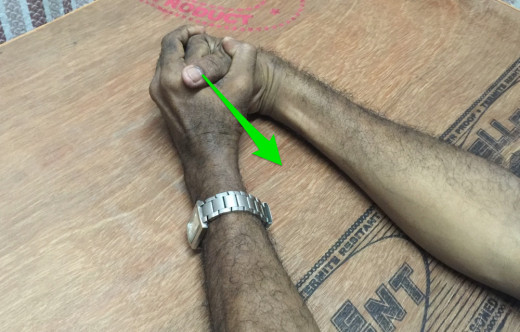
14. Stretching Exercise 4
Let the patient has right Carpal Tunnel Syndrome.
Starting Position- The patient sits on a chair near a table facing it. He keeps his right forearm and right hand on the table in such a way that the ulnar border (inner side) of the right forearm and right hand rest on the table with the right wrist in the neutral position and the fingers held extended.
Exercise- Make a ‘fist’ with the right hand and flex (bend) the right wrist approximately to 90 degrees, so that a stretch is felt along the extensor aspect (back side) of the right forearm. Now hold the dorsal aspect (back side) of the right hand and right fingers which is still held in a ‘fist’ with the left hand in such a way that the ‘fist’ lies within the left hand. Now the left hand applies an extra pressure on the dorsal aspect of the right hand and fingers which is still held in a ‘fist’ pulling it further inward so that a maximum stretch is felt along the extensor aspect (back side) of the right forearm. Hold in the maximum stretched position for 2 seconds. Now slowly and gently release the ‘hold’ and bring back the right wrist to the neutral position and the fingers extended. Repeat the exercise 5 times, thrice a day- may be progressed to 10 times, thrice a day. Avoid severe strain to the wrist.
Care should be taken that the exercise, in anyway, should not precipitate or enhance the symptoms.
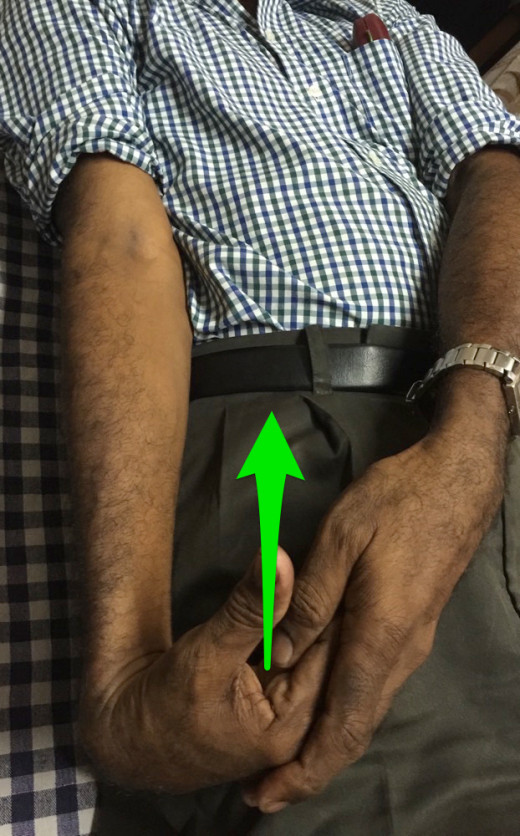
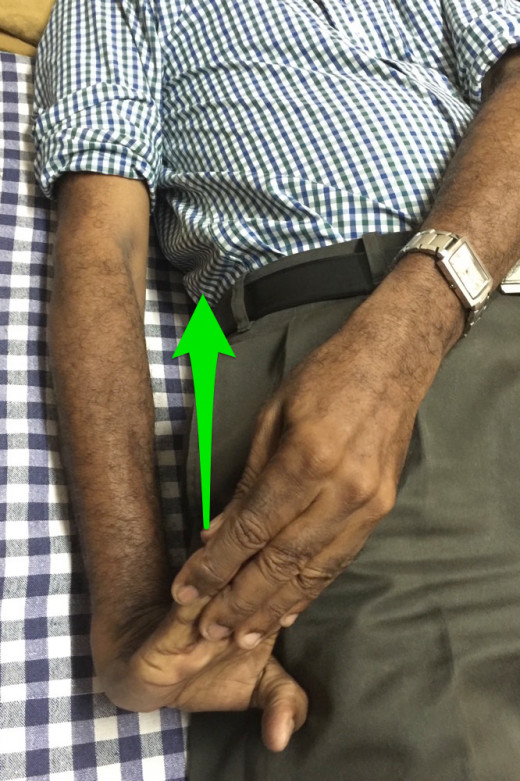
Others
Stretching exercises can also be done in lying positions. Avoid if it precipitates or enhances the symptoms.

